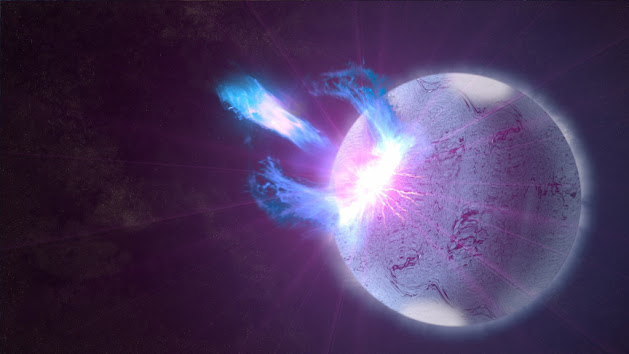Astronomers have discovered a mystery spinning object in the Milky Way that releases a radio wave beam every 18 minutes and is unlike anything else they have ever seen.
(Image credit: An artist’s rendering of what the thing would look like if it’s a magnetar.) (Photo courtesy of ICRAR)
Every 18 minutes, the object has been discovered to produce a massive burst of radio radiation.
It might be a brand-new kind of slowly rotating neutron star with an ultra-powerful magnetic field that can be detected by radio telescopes, according to scientists. It is estimated to be roughly 4,000 light years distant.
‘Spooky’ discovery
“It was kind of spooky for an astronomer because there’s nothing known in the sky that does that,” said Natasha Hurley-Walker, who headed the team that discovered the discovery at Curtin University’s International Centre for Radio Astronomy Research.
While the phenomena had been witnessed before – either as extremely brief events that flash on and off within seconds or milliseconds, or as prolonged pulses that last days – radio transients have not been seen before, according to Ms Hurley-Walker.
The team is conducting more study to determine what is creating the energy bursts, but the scientists believe it might be a magnetar, which is a form of “dead” star with an extremely powerful magnetic field.
The thought of a repeated radio signal in space may lead some to believe it is a message from aliens, but Ms Hurley-Walker said the findings covered a wide variety of frequencies, indicating they are of natural origin.
First discovered by a student
Tyrone O’Doherty, a former undergraduate student at Curtin University, originally spotted the object by comparing Milky Way images from March and May 2018 and looked for variations.
“It really feels quite surreal to have found something like this.” he remarked at a news conference, adding that he hadn’t anticipated to make such an interesting find.
Ms Hurley-Walker used vast archives dating back to 2013 to validate the discovery, checking to see whether the telescope had picked up any further activity from the object.
She discovered that it had turned on in the first half of 2018, generating 71 radio signal flashes from January to March before turning off again. The pulses arrived at regular intervals, as she and her colleagues noticed in their own observations.
She explained, “It’s just every 18.18 minutes, like clockwork,”
More information will be obtained by watching the item when it is active again or by looking for comparable things elsewhere in the Milky Way, according to Ms Hurley-Walker.
The scientists also discovered that the newly discovered object appears to be rotating at a far slower rate than previous magnetars, implying that it has outlasted others that endure only a few thousand years.
However, Ms Hurley-Walker suggested that the energy bursts may have been created by an altogether new sort of cosmic object.
“We didn’t anticipate this type of radio emission to be conceivable,” she explained, “but the fact that it occurs informs us that some kind of severe physical processes must be occurring.”
The findings were published in the journal Nature this week by the researchers.

